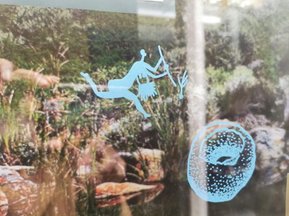Trammakassie // Permanent Environmental Exhibition @ Simonstown Museum, Cape Town
Before Simon's Bay
I assisted in conceiving the Environmental Exhibition at the Simonstown Museum which had not changed since the 1980's, during Apartheid. We chose to tell untold stories from a time before the area was dubbed Simonstown, or Simon's Bay named after a colonial governor. These stories saw us travel back millennia through a multitude of personhoods and ecological systems, oceans rising and receding, tales of many travelers and nomads, indigenous peoples, and ultimately tales of tragedy, genocide, ecocide and brutality. We chose to walk this work through healing, doing research trips to surrounding areas and holding ceremonies for the sufferings that still continue today.
My ultimate exhibition was two installations, a pantry, colloquially known as a kassie and an information cabinet telling the story of our ancient history, embedded in land and sea. We chose the name Trammakassie, a creole word for thank you, adapted from the Indonesian tera makasih brought here through enslavement and a word that is thick with identity, story and history within the Cape.
From the exhibition:
"To build a pantry, colloquially known as a kassie, is a gentle and slow process to build food preserves not only in times of scarcity, but to hold harvest times beyond the seasons. These days our foodscape is beyond what we are able to find on our shores and in the veld. Foods from across the world arrives to our shores and has largely overtaken our knowledges to be able to generate our own food from what we know and have been taught. Incorporating indigenous foods with some of the traditional foods is a manner of reviving lost ways and inspiring our community to take it up again. This kassie aims to highlight some of the foods we may find if we turn to land and sea again, as well as drawing on our communities to share favourite recipes and preserves. A kassie is also a reserve for recipes to stand through stretches of time, sometimes food lasting for years. It is space for potential gifts, unexpected visitors and a way to bulk up meals."
Exhibition Images
The first cabinet we reinformed using an image of Cape Point scenery as the backdrop, imagining how biodiversity may still thrive if our development in land and time was not brutally intruded upon by colonialism. "Our history is ancient and embedded in land and sea" was the title I chose as it speaks to many who have come here historically and how our stories are interwoven with land.
Using botanical and sea pressings to illustrate connection and bring a sense of eternal life to the displays, I intermingled anecdotal and interesting information often left out of general historical narrative.
Trammakassie, various jars and plates and foods displayed, made by Zayaan or gathered form community member around the city, speaking to land, sea, existing traditions and the creation of new ones.
Waalvis Olie (whale oil) was rendered close to where the museum stands and apart from being traditional oil rendered from beached whales, it became industry and was wdely available to the point that today people still call vegetable oil or cooking oil visolie.
A closeup of our introductory cabinet, "Our history is ancient and embedded in land and sea" speaking to the lies of current history that say this land was empty of people when colonisers arrived (still taught in schools today), yet this land is an origin of humanity.
Process images
Coastal herbs and vegetables were harvested from parking lots and building sites where the plants were to be removed. These were part of the botanical pressings.
Strong smelling citronella Pelargonium in process of pressing, the fragrance lingers for years after pressing.
Slangbessies, similar to goji berries but more savoury (a kind of less acidic tomato) resting in an infusion to last and last in the permanent exhibition.
Bietou berries contain a seed that snaps when you bite into it, I chose to make tameletjie seed brittle encased in wood glue to ensure the sugar does not absorb water and melt into the display. Gathering these before the birds did was a noble feat.
After gathering and cleaning foods, I smoked them to fumigate against any damaging insect larvae, eggs, fungi or bacteria.


















